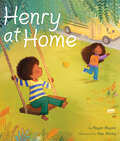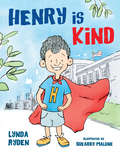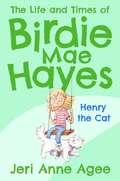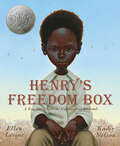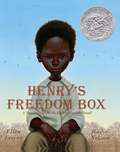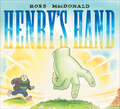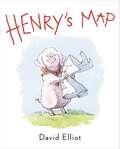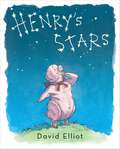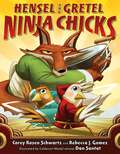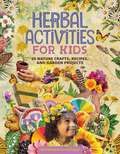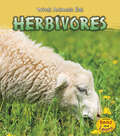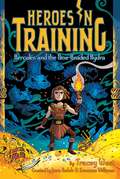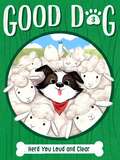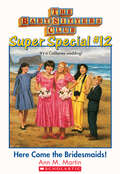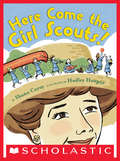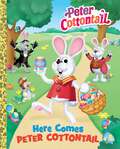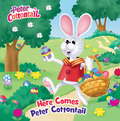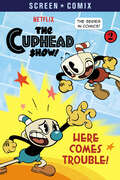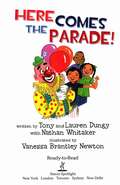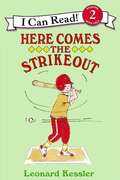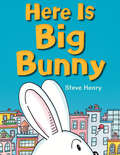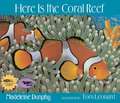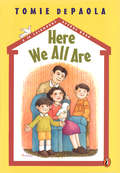- Table View
- List View
Henry at Home
by Megan MaynorThe love between a brother and sister shines through in this reassuring picture book about a common childhood transition—an older sibling starting school and leaving the younger one behind.Liza is Henry's big sister, and Henry is Liza's little brother. As long as there has been a Henry and Liza, they have always done everything together. Haircuts, birthday parties, tree climbing, even flu shots. Liza and Henry. Henry and Liza. But that all changes when Liza starts school for the first time, heading off to kindergarten and leaving her little brother behind. Henry is incredulous. How can Liza do this to him?This true-to-life picture book, gorgeously illustrated, explores a sweet sibling relationship and carries an important and reassuring message about family and growing up.
Henry is Kind: A Story Of Mindfulness
by Shearry Malone Linda RydenA classroom-tested resource for social and emotional learning Henry’s discovery of the many ways he can be kind will inspire young readers to use the simple mindfulness practices taught in this book to develop their own capacities for kindness. Ms. Snowden and her class practice sending kind thoughts to the people they love, and they launch a class Kindness Project. There is only one problem: Henry can’t think of one kind thing he has done. Declaring that kindness is stupid, he stomps to the classroom door on the verge of tears, but his classmates save the day by reminding him of the kind things he has done for each of them.
Henry the Cat: The Life and Times of Birdie Mae Hayes #2 (Life and Times of Birdie Mae Hayes #2)
by Bryan Langdo Jeri Anne AgeeBirdie has a new pet—that no one else can see!Birdie Mae Hayes is getting a handle on her new gift: her ability to sense and see things before they happen. Then, one morning, a fluffy white cat appears at her window, making himself at home. Cute! She names him Henry. Only . . . no one else can see this cat. Just Birdie. Here we go again!Even Grandma Mae doesn't know why Henry the cat is there. But he keeps showing up, and he seems to know things that even Birdie's gift doesn’t show her. Is he there to help Birdie—or is there something he needs from her? Birdie is ready to find out on an adventure all over town!
Henry's Freedom Box
by Ellen LevineA stirring, dramatic story of a slave who mails himself to freedom by a Jane Addams Peace Award-winning author and a Coretta Scott King Award-winning artist.Henry Brown doesn't know how old he is. Nobody keeps records of slaves' birthdays. All the time he dreams about freedom, but that dream seems farther away than ever when he is torn from his family and put to work in a warehouse. Henry grows up and marries, but he is again devastated when his family is sold at the slave market. Then one day, as he lifts a crate at the warehouse, he knows exactly what he must do: He will mail himself to the North. After an arduous journey in the crate, Henry finally has a birthday -- his first day of freedom.
Henry's Freedom Box: A True Story From The Underground Railroad
by Ellen Levine Kadir NelsonA stirring, dramatic story of a slave who mails himself to freedom by a Jane Addams Peace Award-winning author and a Coretta Scott King Award-winning artist. <P> Henry Brown doesn't know how old he is. Nobody keeps records of slaves' birthdays. All the time he dreams about freedom, but that dream seems farther away than ever when he is torn from his family and put to work in a warehouse. Henry grows up and marries, but he is again devastated when his family is sold at the slave market. Then one day, as he lifts a crate at the warehouse, he knows exactly what he must do: He will mail himself to the North. After an arduous journey in the crate, Henry finally has a birthday -- his first day of freedom.<P> Winner of the Caldecott Honor
Henry's Hand
by Ross MacdonaldHenry’s Hand is a story about the friendship between Henry, a giant, and his right hand. You see, Henry sometimes has trouble keeping track of his body parts—everything from his ears to one of his legs can fall off. Once, his eye even rolled under the couch and wouldn’t come out until bedtime. But with help from Hand, Henry keeps himself together. In fact, Henry and Hand are the best of friends . . . that is, until Henry takes Hand for granted, pushes him too far, and Hand runs away. A charming tale of friendship, forgiveness, and loyalty, Henry’s Hand is also a quirky story for readers of all ages, especially those of us who know what it feels like to fight with your best friend.
Henry's Happy Birthday
by Holly KellerRelates the disappointments and joys of Henry's birthday party. From the moment Henry wakes up on his birthday one thing after another goes wrong. Henry is disappointed and gets grouchy and mad. Then, to his surprise, things get better and better. An engaging , short book to read aloud to young children or just right for first or second grade children to read for themselves. Pictures are described.
Henry's Map
by David ElliotA fun-filled introduction to maps through the eyes of an adorable pigHenry is a very particular sort of pig. "A place for everything and everything in its place," he always says. But when he looks out his window he is troubled. The farm is a mess! Henry is worried that nobody will be able to find anything in this mess. So he draws a map showing all the animals exactly where they belong. And Henry embarks on a journey through the farm, his friends tagging along as he creates his map: sheep in the woolshed, chickens in the coop, the horse in the stable. After the map is complete, Henry uses it to bring himself back home, where he is relieved to know that he is exactly where he belongs. A place for everything and everything in its place, indeed.For fans of Zen Shorts by Jon J. Muth or of Winnie the Pooh, this sweet romp through the farm is adorably illustrated by David Elliot, who created the endearing animals who inhabit Brian Jacques world of Redwall. Perfect for pre-schoolers and elemetary-schoolers learning to read maps for the first time.Praise for Henry's Map:*** “With appealing characters and gentle humor, this book will be a hit at storytime, or as an introduction to mapping lessons.” —School Library Journal *** (starred) *** “Here’s hoping for many more Henry-centric adventures.” —Kirkus Reviews *** (starred) “Elliot’s barnyard animals brim with personality and emotion, matching the understated humor of this charming story.” —Publisher’s Weekly “This story may even inspire budding cartographers to map their own world.” —Booklist
Henry's Stars
by David ElliotThe stars take shape in this adorable companion to Henry's Map! One beautiful evening on the farm, Henry stares up at the sky. As he looks from star to star, they seem to form a picture. He sees it! A great big starry pig! Henry can&’t wait to show his friends. Yet instead of seeing the Great Pig&’s ears, legs, and curly tail, the sheep see a woolly body . . . the Great Sheep! Abigail sees the Great Star Cow, of course, and the chickens spot Heavenly Hens flying all over the place. Henry is frustrated. Why don&’t the others see what he sees? In this charming companion to Henry&’s Map, David Elliot explores—with gentle humor—the nature of art and perception. A perfect book for kids and adults who love to find shapes among the stars or anywhere else their imaginations may lead.Praise for Henry's Stars"Elliot&’s watercolor and pencil illustrations seamlessly blend the realism and farce that makes this story work so well. Teachers will enjoy using this story to exemplify point of view or introduce a unit on constellations. Younger audiences will relate to Henry and delight in the predictability of his predicament. This modern-day fable deserves a place in most collections."—School Library JournalPraise for Henry&’s Map One of School Library Journal's Best Books in 2013! * &“With appealing characters and gentle humor, this book will be a hit at storytime, or as an introduction to mapping lessons.&” —School Library Journal, starred review * &“Here&’s hoping for many more Henry-centric adventures.&” —Kirkus Reviews, starred review &“Elliot&’s barnyard animals brim with personality and emotion, matching the understated humor of this charming story.&” —Publishers Weekly &“This story may even inspire budding cartographers to map their own world.&” —Booklist
Hensel and Gretel: Ninja Chicks
by Corey Rosen Schwartz Rebecca J. GomezA clever twist on Hansel and Gretel that proves ninja chicks are anything but chicken! When Hensel and Gretel&’s dad gets snatched by a fox, the sisters put their ninja skills to work to track him down before he can be stir-fried. But are these two little chicks ready to take on a dark tangled forest, a tricky house made of corn bread, and an even trickier fox? This plucky pair isn&’t giving up without a fight! Kiya!Kids will fight over this new offering from the team behind The Three Ninja Pigs and Ninja Red Riding Hood.
Herbal Activities for Kids: 50 Nature Crafts, Recipes, and Garden Projects
by Molly Meehan BrownA rich, colorful compendium of crafts, cooking, gardening, and nature exploration activities introduces kids ages 7 and up to the versatility and creative fun of working and playing with herbs. From dandelions to lavender, chamomile, turmeric, and lemon balm, herbs include a wonderfully diverse range of plants for crafting, cooking, and gardening. Kids will love exploring the world of herbs with this lively and colorful collection of 50 nature-based activities created by Molly Meehan Brown and the global community of herbalists who contribute to the Wild Ginger Community Herbal Center. Filled with photos and the whimsical art of Madison Safer, this eclectic and colorful compilation volume features easy-to-follow projects that engage all five senses. Includes activities for different ages and interests such as: How to make a pressed flower and herb collage Tie-dye fabric with turmeric Make elderberry syrup Plant a pollinator garden Make wild berry crumble Craft an herbal wreath or a flower bracelet Write a nature haiku Make lemon balm lip balm, and more! With bits of lore about herbs and herbalism sprinkled throughout, this is the perfect introduction to the versatility and usefulness of herbs for kids ages 7 and up.
Herbivores (What Animals Eat Ser.)
by James BenefieldWhat do herbivores eat? Mostly food from plants! Find out what classifies an animal as a ‘herbivore,’ as well as how common features like tooth shape reflect an animal’s diet. Get and in-depth look at a wide range of fascinating animals from around the world and introduce readers to ideas about the relationships between animals.
Hercules and the Golden Apples [On Level, Grade 2]
by Betsy Hebert Yevgenia NaybergNIMAC-sourced textbook
Hercules and the Nine-Headed Hydra (Heroes in Training #16)
by Tracey WestZeus and his friends are back for another adventure in this latest Heroes in Training chapter book!Since defeating the Titans, Zeus and his fellow Olympians have taken over Mount Olympus. Things are nearly back to normal…until a stranger named Hercules shows up, asking for help. He&’s on the run from Eurythseus, King of Argon, who is after Hercules for egging his temple. Before Zeus can help, Eurythseus himself appears. It turns out that Hercules has also been bragging that he is the ruler of Olympus, and Eurythseus intends to declare war on the Olympians&’ new home. Zeus&’s friends come up with an idea—maybe Hercules could make up for egging Eurythseus&’s temple. The Oracle Pythia reveals that in order to do this, Hercules must get a scale from a huge, nine-headed serpent—the Hydra. Will this be enough to please Eurythseus? Or is another battle on the horizon for the Olympians?
Herd You Loud and Clear (Good Dog #3)
by Cam HigginsIn the adorable third book of the Good Dog series, Bo learns to herd the sheep on the farm—the hard way!Loveable puppy Bo Davis has his work cut out for him when he has to herd the farm&’s sheep by himself! With easy-to-read language and illustrations on almost every page, the Good Dog chapter books are perfect for beginning readers.
Here Come the Bridesmaids!: Here Come the Bridesmaids! (The Baby-Sitters Club Super Special #12)
by Ann M. MartinThe Baby-Sitters are invited to weddings on both coasts in this entry from the classic, hit series.When two weddings give three club members the opportunity to be bridesmaids, Claudia and Dawn excitedly fly out to California to participate in Dawn’s father’s nuptials, while an enthusiastic Stacey attends Mrs. Barrett in Stoneybrook. The best friends you’ll ever have—with classic BSC covers!
Here Come the Girl Scouts!: The Amazing All-true Story of Juliette "Daisy" Gordon Low and Her Great Adventure
by Shana CoreyThe amazing, all-true story of the first Girl Scouts and their visionary founder.Juliette Gordon Low--Daisy to her friends and family--was not like most girls of the Victorian era. Prim and proper? BOSH! Dainty and delicate? HOW BORING! She loved the outdoors, and she yearned for adventure! Born into a family of pathfinders and pioneers, she too wanted to make a difference in the world--and nothing would stop her. Combining her ancestors' passion for service with her own adventurous spirit and her belief that girls could do anything, she founded the Girl Scouts. One hundred years later, they continue to have adventures, do good deeds, and make a difference!
Here Comes Peter Cottontail Big Golden Book (Big Golden Book)
by Golden BooksBoys and girls ages 3 to 7 will love this beautifully illustrated Big Golden Book retelling of the classic Peter Cottontail Claymation TV special from 1971.
Here Comes Peter Cottontail Pictureback (Pictureback(R))
by Mary Man-Kong Random HouseChildren ages 3 to 7 will love to celebrate Easter with this full-color storybook based on the classic Peter Cottontail Claymation TV special from 1971. Plus, it features press-out Easter egg holders and over 30 stickers!
Here Comes Trouble! (Screen Comix)
by Random HouseTwo episodes of The Cuphead Show! retold in graphic novel-style deluxe paperback with full-color images and dialogue from the animated Netflix series, featuring Cuphead and Mugman!The Cuphead Show! follows the adventures of two lovable brothers—Cuphead and Mugman—through their unique misadventures! Whether it&’s angry mermaids, boxing frogs, or strange carnivals filled with danger, the brothers often find themselves in hot water. But whoever—and whatever—they encounter on their home of Inkwell Isle, they&’ve always got one another&’s backs. Fans of the animated Netflix series and the video game that inspired it will love the second 80-page graphic novel-style Screen Comix with full-color images and dialogue from the laugh-out-loud series!
Here Comes the Parade!: Ready-to-read Level 2 (Tony And Lauren Dungy Ready-to-reads Ser.)
by Tony Dungy, Lauren DungyWhen they find a lost wallet at the parade, the Dungy children learn an important lesson about telling the truth and doing the right thing.
Here Comes the Strikeout! (I Can Read! #Level 2)
by Leonard KesslerHitting the ball is hard work, but after lots of practice and advice from his friend Willy, Bobby learns how.
Here Is Big Bunny
by Steve HenryWhose giant foot is that? Where are those ears going . . . ? Through windows, behind trees, and behind buildings, Big Bunny is peeking out. More than one hundred fifty colorful animal characters, busily walking through their city, stop and look at the giant bunny in their midst. What could all of these clues add up to? Why, it's Big Bunny—a huge balloon, sailing down the street with a smile in the middle of a parade! Beginning readers will love searching through Steve Henry's detailed spreads for hints, looking for Big Bunny in each spread. The text features brief, simple sentences with no more than one word changing from page to page, making this one of the first books a child will be able to read on their own. For older readers, an author's note explains the inspiration behind the story, artistic influences, and some of the unexpected treasures hiding on the page. Bold colors and creative cutaways make this a fun read, and there's always some new detail to discover!
Here Is The Coral Reef
by Madeleine Dunphy Tom LeonardSet in Australia's Great Barrier Reef, this lyrical rhyming tale introduces young readers to some of the coral reef's most striking residents. From the sleek shark to the colorful parrotfish to the deceptively beautiful sea anemone, each creature in this abundant undersea world relies on another for its existence. Beginning with coral, the very element that defines this ecosystem, Madeleine Dunphy uses a cumulative approach, combining simple yet forceful verse with repetition to reveal the fragile chain that links each of the plants and animals in this unique environment. Tom Leonard's vibrant paintings capture this miraculous circle of life.
Here We All Are
by Tomie DepaolaIn a wonderfully warm and funny sequel to 26 Fairmount Avenue, Tomie takes us back into his childhood home as he helps the family get ready for the new baby. Along the way are funny school experiences such as "revenge" at not getting to play Peter Rabbit in the school play because he talks too much, becoming a star at Miss Leah's Dance School, having to eat Nana Fall-River's "sewer-pipe" macaroni, and missing his mom when she goes to the hospital to have the baby. Favorite characters from 26 Fairmount Avenue as well as from his "autobiographical" picture books, Nana Upstairs, Nana Downstairs, The Baby Sister and Tom make appearances here. Another winning chapter book.
